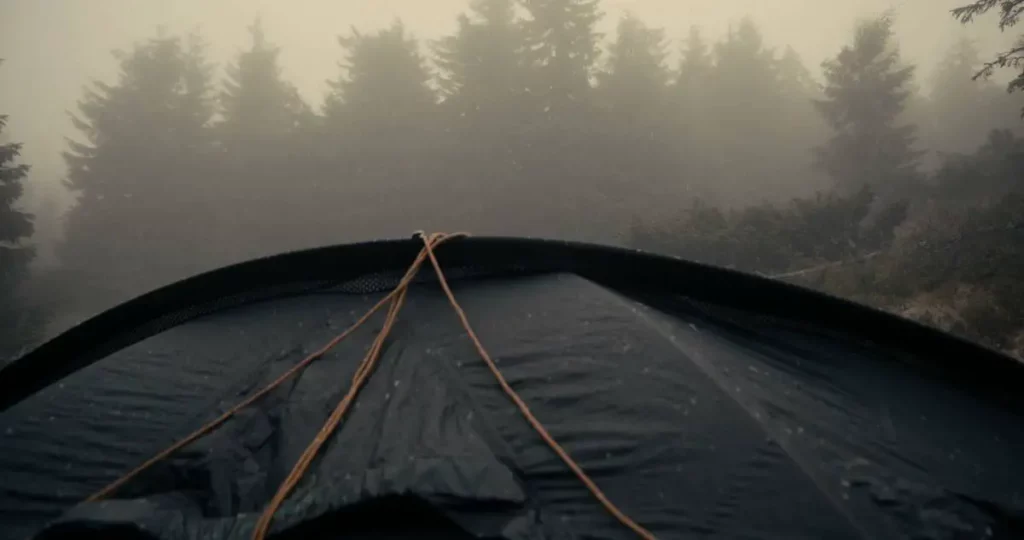This post contains affiliate links.
Tear-down is by far the worst part about camping. It’s always harder to fit everything in your car or backpack than when you began. Rain makes this process even more painful because no one likes packing up a wet tent. If you’re like us, you may be wondering if there are any ways to take down a tent easier in the rain without getting everything wet.
Using a standalone rain fly or pop-up fly will ensure your tent remains as dry as possible during tear-down. Keep your wet tent/fly separated from your dry items with a plastic bag. Set up or hang your wet tent as soon as possible to prevent mold and mildew.
Whether you’re a backpacker, hunter, or weekend camper, you’ve probably had those trips where the rain just won’t stop. It’s probably tempting just to drop the tent as fast as possible and shove the entire thing into your tent bag or backpack.
However, there are several tricks to help keep you and your things relatively dry. While you can’t fully prevent getting wet during tear down, this article will provide you with some tips on taking down, packing, and drying out a wet tent.

Table of Contents
Why Proper Tent Take-Down is Important
Whether you’re heading home or going to your next destination, it’s essential to take your tent down with care.
If you are on an extended camping trip and plan to use your tent again the following night, proper take-down can mean the difference between a wet or dry sleep. For backpacking, dropping your tent pieces in the wrong order could mean a soggy next night.
If your trip is at an end, minimizing water exposure to your stuff will make unpacking and cleaning much easier. Additionally, you want to make sure you don’t store your tent wet.
In any environment, mold and mildew thrive on damp camping gear. This is because something like a tent is usually packed so tightly that water sticks around long after the outside of the package has dried.
How to Take a Tent Down in The Rain
Regardless of the kind of tent you have, the following guide offers steps to taking each type down while in the rain:
Backpacking Tents
Specially designed backpacking tents are made for quick and easy setup/take-down. Many of these come with a separate fly that can be set up first. In these cases, set up and take-down are fairly easy.
Other common styles use pole clips to connect the interior tent to the poles. This design also allows you to remain under the protection of your rain fly while packing your gear and tent into your backpack.
- 【Easy Setup Tents for Camping】Comes with a manual hand pump to allow you to inflate the tent during 10 minutes. Everybody can completely...
- 【Oxford Camping Tent】This tent is made of high-density Oxford cloth, which has waterproof as well as excellent UV-proof functions, it...
- 【4-6 Persons Large Tents for Camping】This tent provides plenty of space, you can put the table in the tent to use. And it can...
Isolating Wet and Dry Camping Gear
On any camping trip, it’s always a good idea to pack a waterproof plastic bag to separate your wet and dry gear. This can be a specialty pack liner or simple heavy duty trash bag. These will keep your wet items isolated in case you encounter rain during your trip.
The two schools of thought on this topic revolve around whether to pack your dry gear in the bag or your wet gear.
In the case of a pack liner, you’ll likely have all your gear inside the bag already and therefore it makes most sense to keep your wet rain fly between your liner and the outside wall of your backpack.
- Roll-top waterproof closure
- Waterproof-coated fabric and seams
- Rectangular shape for efficient packing
If you don’t already have all your gear in a liner or plastic bag then stashing your wet gear in it and strapping it to the outside of your pack may be your best option. As soon as you get to a sunny spot, you should stretch or hang your wet items out to dry.
For a demonstration on using a pack liner to protect your dry gear from getting wet, check out this video from Sierra Trading Post.
Using A Stand Alone Rainfly
When you do arrive at your campsite, you want to make sure you pick a spot that is on a mound rather than in a low lying area, this way it’s less likely to collect a lot of water around the base. This is especially important if you are in an area where rain is likely.
The rain fly should be the first thing you set up, and the last thing you take down. You can use trekking poles to keep your rain fly in place, so it stands without support from your tent. If you happen to encounter rain during take-down, this will provide you with a dry spot to pack away your gear.
Then, it’s just a few simple steps to ensure the driest packing possible:
- Fold the dry parts of your tent toward the middle.
- The wet bottom should stay on the outside.
- Pack the tent inside or on the outside of your backpack.
- Drop the fly, keeping the underside as dry as possible.
- Give the fly a few good shakes if necessary.
- Fold with the dry part on the inside.
- Pack the wet fly against the wet floor of your tent.
Large Camping Tents
For larger tents, it may be more challenging to take the tent down under the rain fly. Nylon tents require additional rain protection, so most come with a separate or integrated rain fly. Canvas tents themselves are waterproof but don’t typically have a separate rain fly.
Nylon Tents
Tents With Pole Sleeves
If your tent uses sleeves rather than pole hooks to connect the interior tent to the poles, the rain fly most likely needs the structure of the tent to stand. This means you will not be able to take the shelter down until after the rain fly is off. Getting the tent wet in this case is almost inevitable.
However, you can reduce the likelihood of getting drenched a couple of ways. The first is by having an overhead tarp protecting your tent from the rain. This is a popular method for large tents.
Another option is to pack up all your tent camping gear from inside your tent so it is empty and lightweight. At this point remove your pegs and drag the tent under a protected area like a tree canopy, gazebo or other covered spot. if you bring along a portable pop-up shade, you can always move that over your tent to keep some water off during take-down.
- HEAVY DUTY OUTDOOR TARP: This 10mil thick tarp is sure to endure the test of time. Made from premium polyethylene material for durability...
- TOP NOTCH PROTECTION: Keep your equipment and stuff safe in severe weather. These weatherproof and waterproof covers keep rain, snow or wind...
- SUN AND WATER PROTECTION: With UV blocking, these drop cloths protect your belongs from sun damage. They also protect from moisture, dust...
Tent With Integrated Rain Fly
The second type of tent, that with an integrated fly, is much easier to take down in the rain. The fly on the outside and integrated waterproof bottom sandwiches all the dry nylon between them. Since it all packs in one bag, you can just wrap the dry stuff inside the wet exterior.
Using a large mesh duffle bag is a good way to allow your tent to breath and dry a bit to reduce the build up mildew before you’re able to air it all out. The bigger the bag, the looser you can pack it and the better it will be.
- Spacious Dive Bag for All Your Gear: Our extra-large mesh duffle bag is designed to hold all your scuba gear, snorkeling equipment,...
- Quick Rinse & Fast Drying: The breathable mesh material allows you to rinse off saltwater, sand, or dirt while your gear stays inside,...
- Multiple Storage Options for Small Essentials: A zippered side mesh pocket securely holds small items like keys, sunscreen, sunglasses,...
Canvas Tents
Canvas tents can be treated or untreated. Many prefer the untreated variety because it allows for more airflow when it’s hot outside. Regardless of the treatment, canvas tents swell when wet, keeping the water out.
This surface tension prevents leaks and keeps your stuff dry. However, when you break that surface tension, it can lead to drips or condensation on the inside of the walls. While this is not much of a danger to the things inside the tent, it can cause the whole canvas to become wet while packing.
This is the time when using an overhead tarp to direct the rain away from your tent is the best solution. There are few other ways to prevent a canvas tent and you from getting wet while taking it down in the rain. If the forecast calls for rain plan on bringing a large tent and some strong cord or rope to hang it between trees.
Drying Out Your Tent
Whether you’re using a small backpacking tent or a large nylon or canvas one, it’s essential to completely dry your tent out after use. It is recommended that you store a rolled-up, wet tent for no more than 12-20 hours. After that, you will be looking at mold and mildew problems that are difficult to get rid of.
Most tents dry out the same way: Being set up, hung up or laid out in a dry place.
There are a few simple steps to ensure any tent, but especially your canvas, one is dry and ready for your next camping trip.
- Setup your wet tent in an open sunny area and hang any tarps and rainflys separately.
- Exposure to UV rays will prevent any mildew or mold from proliferating.
- Check all sides at the top and bottom to ensure the material is dry.
- Check if the ground attachments are dry (especially nylon webbing).
- Store the tent off the ground rolled loosely in a mesh bag or hanging.
If you notice any leaks through your tent walls, seams or rainfly it may be time to apply a new coat of waterproofing to the outside of your tent. Once your tent is set up and dry take the opportunity to treat it with a waterproofing spray to prevent waking up in a pool of water on your next camping trip.
Conclusion
Ultimately, if you’re camping in the rain, you’re going to get a little wet. As the tent is your last line of protection against the water, it will be the one sacrificed to it. However, while it will never be fun to take a tent down in the rain, it is possible to do it efficiently.
Always try to keep your dry items separated from the wet ones to ensure comfort while camping or backpacking from place to place. If you can minimize the number of surfaces exposed to rain, you will have less clean up in the end.
Drying out and properly storing your equipment after each excursion is a must. This will ensure that your next adventure starts on the right path!




